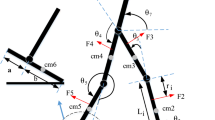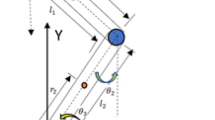Abstract
In this paper, a novel hybrid optimal Adaptive High-Order Super Twisting Sliding Mode (AHOSTWSM) impedance control is proposed for a lower limb exoskeleton robot with 7 active joints, which takes the interaction forces between the robot and the user into account. First, the dynamic model of the robot is extracted using Lagrange approach. Then, an adaptive super twisting sliding mode controller is designed based on Lyapanov theory. Moreover, the interaction forces are obtained in every time-step and applied to the robot as a compensating torque to guard against disturbances. The desired trajectory of the upper limb joint has been extracted so that the stability of the robot is achieved based on Zero Moment Point (ZMP) criterion at any moment. Moreover, to achieve optimal performance (maximum stability, minimum tracking error, reduced interacting forces, and optimal energy consumption), parameters of the proposed controller, the upper limb desired trajectory, and the impedance system are optimized using Harmony Search Algorithm (HSA). Finally, in order to demonstrate the effectiveness of the proposed controller, optimal sliding mode controller (SMC) is designed and performance of the AHOSTWSM is compared with SMC. The simulation results reveal the superiority of the controller in comparison with SMC.














Similar content being viewed by others
References
Banala SK (2009) Robot assisted gaittraining with active leg exoskeleton (ALEX). IEEE Trans Neural Syst Rehabil Eng 17(1):2–8
Shamaei K, Napolitano PC, Dollar AM (2013) A quasi-passive compliant stance control knee-ankle-foot orthosis. Rehabilitation Robotics (ICORR), 2013 IEEE international conference on IEEE
Grabowski AM, Herr HM (2009) Leg exoskeleton reduces the metabolic cost ofhuman hopping. J Appl Physiol 107:670–678
Kerdok AE, Biewener AA, McMahon TA, Weyand PG, Herr HM (2002) Energetics and mechanics of human running on surfaces of different stiffnesses. J Appl Physiol 92:469–478
Herr H (2009) Exoskeletons and orthoses classification design challenges and future directions. J NeuroEng Rehabilit 6(1):1–9
Dollar AM., Herr H (2008) Design of a quasi-passive knee exoskeleton to assist running. In: Intelligent Robots and Systems, 2008. IROS 2008. IEEE/RSJ international conference on IEEE, pp.747–754
Robert B (2009) Exoskeletons and robotic prosthetics: a review of recent developments. Ind Robot Int J 36:421–427. https://doi.org/10.1108/01439910980141
Aaron D, Hugh H (2008) Lower extremity exoskeletons and active orthoses: challenges and state-of-the-art. IEEE Trans Rob 24:144–158. https://doi.org/10.1109/TRO.2008.915453
Vukobratovic M, Borovac B, Surla D, Stokic D (1990) Biped locomotion. Springer-Verlag, Berlin
Kazerooni H, Sreger R, Huang L (2006) Hybrid control of the berkeley lower extremity exoskeleton (BLEEX). Int J Robot Res 25:561–573. https://doi.org/10.1177/0278364906065505
Walsh CJ, Pasch K, Herr H (2006) An autonomous, under actuated exoskeleton for load-carrying augmentation, IEEE/International Conference on Intelligent Robots and. pp.1410–1415. https://doi.org/10.1109/IROS.2006.281932
Banala SK, Kim SH, Agrawal SK, Scholz JP (2009) Robot assisted gait training with active leg exoskeleton (ALEX) IEEETrans. Neural Syst Rehabil 17:2–8. https://doi.org/10.1109/TNSRE.2008.2008280
Herr H (2009) Challenges and state-of-the-art Lower Outhouses extremity exoskeletons and active. J Nero Eng Rehabilit 21:1–9. https://doi.org/10.1186/1743-0003-6-21
Siciliano B, Khatib O (2008) Springer Handbook of Robotics. Springer-Verlag, Berlin, pp 773–793
Jezernik S, Colombo G, Kelly T, Frueh T, Morari M (2003) Robotic Orthosis Lokomat: a rehabilitation and research tool. Neuro Modul 6:108–115. https://doi.org/10.1046/j.1525-1403.2003.3017.x
Mokhtari M, Taghizadeh M, Mazare M (2019) Optimal adaptive high-order super twisting sliding mode control of a lower limb exoskeleton robot. modares mechanical engineering, 19 (3): 777–787. http://journals.modares.ac.ir/article-15-24120-en
Mokhtari M, Taghizadeh M, Mazare M (2020) Hybrid adaptive robust control based on CPG and ZMP for a lower limb exoskeleton. Robotica. https://doi.org/10.1017/S0263574720000260
Mokhtari M, Taghizadeh M, Mazare M (2018) Optimal robust hybrid active force control of a lower limb exoskeleton, Modares Mechanical Engineering. Pp. 342–350. http://journals.modares.ac.ir/article-15-11590-en
Qu Z, Dorsey J (1991) Robust tracking control of robots by a linear feedback law. IEEE Trans Autom Control 36:1081–1084. https://doi.org/10.1109/9.83543
Neila M (2011) Adaptive sliding mode control for rigid robotic manipulator. Int J Autom Comput 8:215–220. https://doi.org/10.1007/s1163-0110576-2
Jeong C, Kim J, Han S (2018) Tracking error constrained super-twisting sliding mode control for robotic system. Int J Control Autom Syst 16(804):816. https://doi.org/10.1007/s1255-017-0134-2y
Edwards C, Colet E, Fridman L (2006) Advances in variable structure and sliding mode control. Springer, Berlin
Levant A (1993) Sliding order and sliding accuracy in sliding mode control. Int J Control 58:1247–1263. https://doi.org/10.1080/00207179308923053
Liang D, Jian L, Ronghai Q (2016) Super-twisting algorithm based sliding-mode observer with online parameter estimation for sensor less control of permanent magnet synchronous machine. IEEE 53:3672–3682. https://doi.org/10.1109/ECCE.2016.7855479
Goel A, Swarup A (2017) MIMO uncertain nonlinear system control via adaptive high-order super twisting sliding mode and its application to robotic manipulator. J Control Autom Electric Syst 28:36–49. https://doi.org/10.1007/s40313-016-0286-7
Shtessel Y, Taleb M, Plestan F (2012) A novel adaptive-gain super twisting sliding mode controller: methodology and application. Automatica 48:759–769. https://doi.org/10.1016/j.automatica.2012.02.024
Nevil H (1985) Impedance control: an approach to manipulation: Part1, Part2, Part3. J Dyn Syst Meas Contr 107:1–24. https://doi.org/10.1115/1.3140702
Karavas N, Ajoudani A, Tsagarakis N et al (2015) Tele-impedance based assistive control for a compliant knee exoskeleton. Robot Auton Syst 73:78–90. https://doi.org/10.1016/j.robot.2014.09.027
Tran H, Cheng H, Rui H et al (2016) Evaluation of a fuzzy-based impedance control strategy on a powered lower exoskeleton. Int J Soc Robot 8:103–123. https://doi.org/10.1007/s12369-015-0324-9
Chen X, Chen W, Wang J, Zhang J (2017) Impedance control for a lower-limb rehabilitation robot, 2017 12th IEEE conference on industrial electronics and applications (ICIEA), IEEE. 1212–1217. https://doi.org/10.1109/ICIEA.2017.8283024
Pa P, Jou J (2010) Design of a bipedal toy robot with an automatic center of gravity shifting mechanism. Adv Mater Res 120:670–674. https://doi.org/10.4028/www.scientific.net/AMR.118-120.670
Messuri D, Klein C (1985) Automatic body regulation for maintaining stability of a legged vehicle during rough-terrain locomotion. Robot Autom IEEE Robot Automat Soc 1:132–141. https://doi.org/10.1109/JRA.1985.1087012
Moosavian A, Alipour K, Bahramzadeh Y (2007) Dynamics modaling and tip-over stability of suspended wheeled mobile robots with multiple arms. In lntelligent robots and Systems, 2007. IROS 2007. IEEE/International Conference on RSJ. https://doi.org/10.1109/IROS.2007.4398999
Takhmar A, Alghooneh M, Alipour K et al (2007) MHS measure for postural stability monitoring and control of biped robots. In Advanced intelligent Mechatronics, 2008 .AIM 2008. IEEE/ASME lnternational Conference on https://doi.org/10.1109/AIM.2008.4601694
Monje C, Martinez S, Pierro P, Balaguer C (2018) Whole-body balance control of a humanoid robot in real time based on zmp stability regions approach. Cybern Syst 49(7–8):521–537. https://doi.org/10.1080/01969722.2018.1552858
Farzaneh Y, Akbarzadeh A, Akbari A (2014) Online bio-inspired trajectory generation of seven-link biped robot based on T-S fuzzy system. Appl Soft Comput 14:167–180. https://doi.org/10.1016/j.asoc.2013.05.013
Kim J (2016) Harmony search algorithm: a algorithm. Procedia Eng 154:1401–1405. https://doi.org/10.1016/j.proeng.2016.07.510
Kawamoto H, Sankai Y (2005) Power assist method based on phase sequence and muscle force condition for HAL. Adv Robot 19:717–734. https://doi.org/10.1163/1568553054455103
Craig J (2017) Introduction to Robotics: Mechanics and Control. Hall, London, pp 85–310
Moosavian SAA, Takhmar A (2007) Stable gait planning for humanoids motion. ISME, Iran
Moreno JA (2012). Lyapunov function for levant’s second order differentiator. In 2012 IEEE 51st IEEE conference on decision and control (CDC) pp. 6448–6453
Fridman L, Moreno JA, Bandyopadhyay B, Kamal S, Chalanga A (2015) Continuous nested algorithms: the 5th generation of sliding mode controllers. Springer International Publishing, Cham, pp 5–35
Seraji H, Colbaugh R (1997) Force tracking in impedance control. Int J Robot Res 16:97–117. https://doi.org/10.1177/027836499701600107
Funding
This study was not funded by anyone.
Author information
Authors and Affiliations
Corresponding author
Ethics declarations
Conflict of interest
The authors declare that they have no conflict of interest.
Additional information
Publisher's Note
Springer Nature remains neutral with regard to jurisdictional claims in published maps and institutional affiliations.
Rights and permissions
About this article
Cite this article
Mokhtari, M., Taghizadeh, M. & Mazare, M. Impedance control based on optimal adaptive high order super twisting sliding mode for a 7-DOF lower limb exoskeleton. Meccanica 56, 535–548 (2021). https://doi.org/10.1007/s11012-021-01308-4
Received:
Accepted:
Published:
Issue Date:
DOI: https://doi.org/10.1007/s11012-021-01308-4




